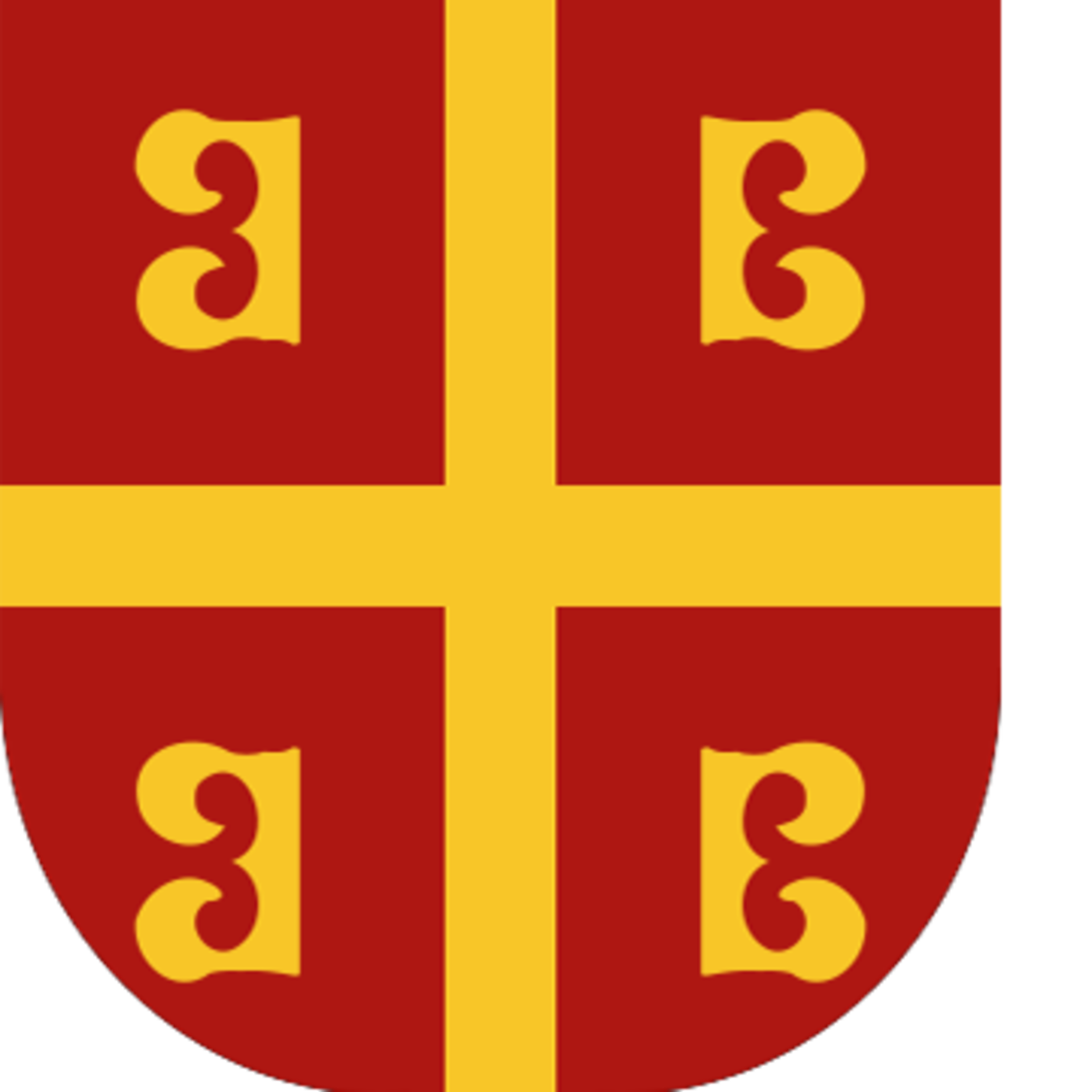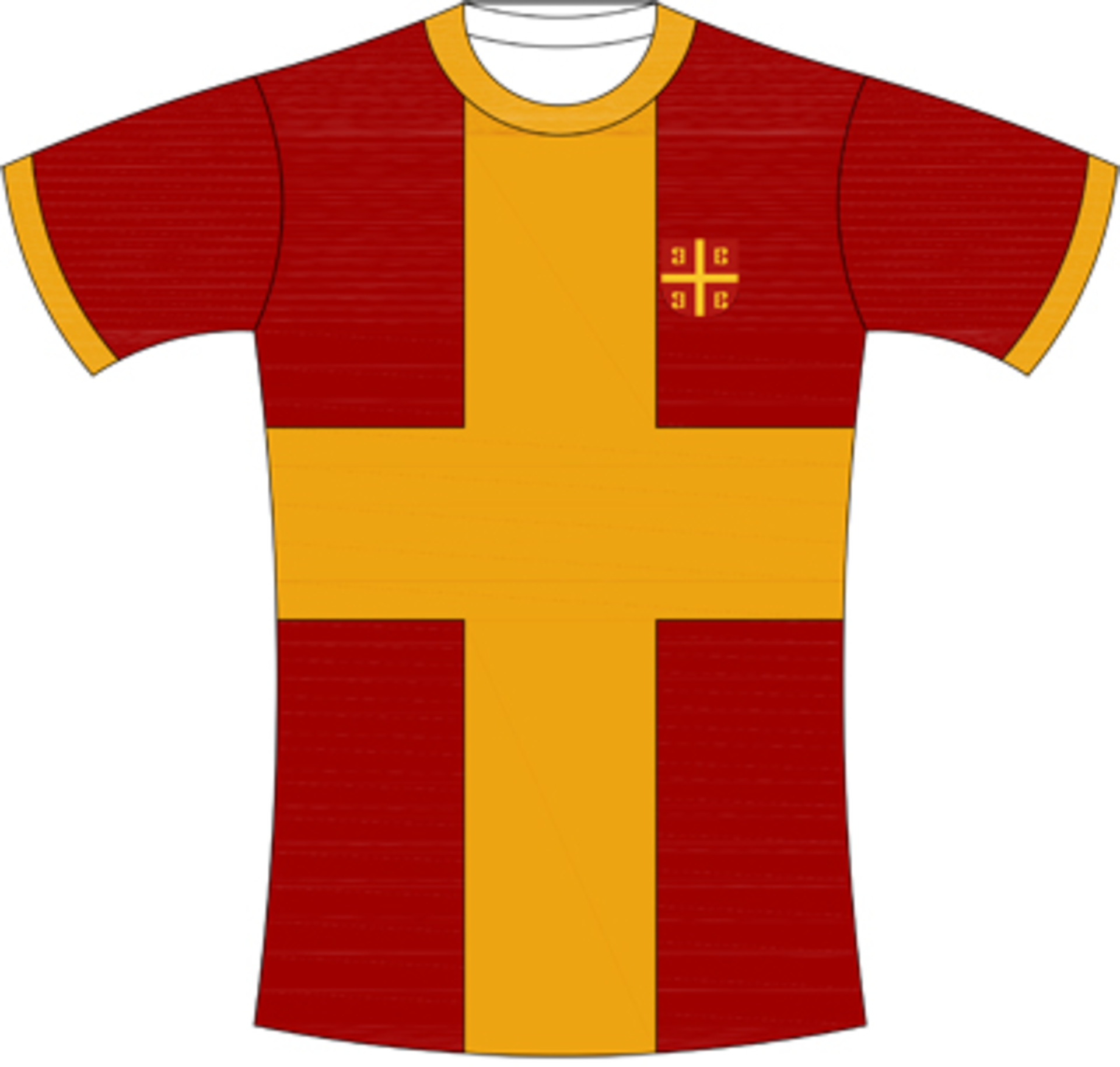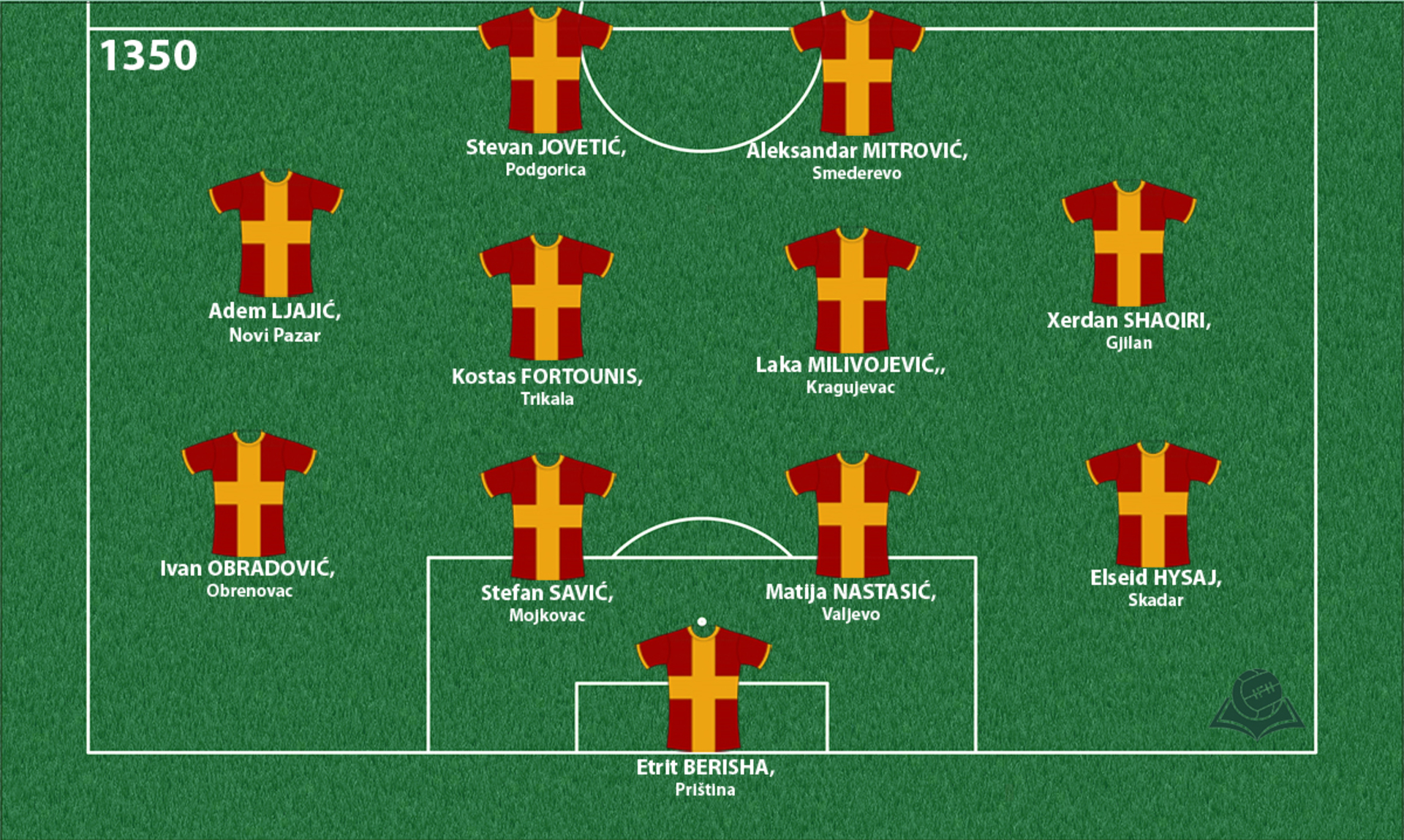The Serbian Empire
The medieval Kingdom of Serbia had it core in the region of Kosovo and Metohija. State will achieved territorial peak in the mid of 14th century during the reign of the king Dušan, who will expand his rule to the south, covering almost the entire Balkan Peninsula. At the same time, considering a decline of the Byzantine, Dušan will declared himself as the Emperor of Serbs and Greeks.

Coat of arms

Shirt
| Position | First name | Last name | Mjesto rođenja | Like | Dislike | |
|---|---|---|---|---|---|---|
| GK | Etrit | BERISHA | Pristina |
17 |
26 |
|
| GK | Predrag | RAJKOVIĆ | Negotin |
27 |
4 |
|
| GK | Vladimir | STOJKOVIĆ | Ložnica |
21 |
2 |
|
| DC | Dimitros | SIOVAS | Drama |
8 |
1 |
|
| DC | Kyriakos | PAPADOPOULOS | Katerini |
15 |
2 |
|
| DC | Matija | NASTASIĆ | Valjevo |
63 |
6 |
|
| DC | Stefan | SAVIĆ | Mojkovac |
46 |
5 |
|
| DRLC | Nenad | TOMOVIĆ | Kragujevac |
22 |
6 |
|
| DRL/MR | Stefan | RISTOVSKI | Skopje |
28 |
10 |
|
| DRL/ML | Naser | ALIJI | Kumnaovo |
7 |
7 |
|
| DR | Elseid | HYSAY | Reç (Shkodër) |
14 |
9 |
|
| DR/MR | Strahil | POPOV | Blagoewgrad |
11 |
9 |
|
| DL/ML | Ivan | OBRADOVIĆ | Obrenovac |
15 |
4 |
|
| DMC | Luka | MILIVOJEVIĆ | Kragujevac |
30 |
9 |
|
| DMC | Nikola | VUKČEVIĆ | Podgorica |
7 |
5 |
|
| MC | Nikola | MAKSIMOVIĆ | Belgrade |
27 |
14 |
|
| MR/DR | Marko | VESOVIĆ | Podgorica |
8 |
2 |
|
| AMRLC | Adem | LJAJIĆ | Novi Pazar |
23 |
4 |
|
| AMRLC | Filip | ĐURIČIĆ | Obrenovac |
9 |
1 |
|
| AMRLC | Kostas | FORTOUNIS | Trikala |
23 |
10 |
|
| AMRLC | Milot | RASHICA | Vushtrri |
4 |
11 |
|
| MRL/DL | Ezgjan | ALIOSKI | Prilep |
3 |
8 |
|
| AMRL | Andrija | ŽIVKOVIĆ | Niš |
18 |
3 |
|
| AMRL | Filip | KOSTIĆ | Kragujevac |
29 |
9 |
|
| AMRL | Lazar | MARKOVIĆ | Čačak |
18 |
7 |
|
| AMRL | Xerdan | SHAQIRI | Gjilan |
44 |
26 |
|
| SS/FC | Mirko | VUČINIĆ | Nikšić |
8 |
6 |
|
| SS/FC | Stevan | JOVETIĆ | Podgorica |
30 |
8 |
|
| FRLC | Admir | MEHMEDI | Gostivar |
5 |
15 |
|
| FC | Dimitar | BERBATOV | Blagoewgrad |
11 |
3 |
|
| FC | Ilija | NESTOROVSKI | Prilep |
24 |
5 |
(Today part of: Southern and central Serbia, Montenegro, Macedonia, Albania, northern Greece, western Bulgaria, south-eastern BiH)
The Grand Principality of Serbia, with its core located between the rivers Drina and Ibar, was elevated to the status of kingdom at the beginning of the 13th century, when the episcope of the Serbian Orthodox Church St. Sava crowned his older brother Stefan. The Church will soon after that also achieve autocephaly under Sava’s leadership, and become an independent member of the Orthodox Church community.
The state achieved its peak during the reign of Dušan Nemanjić (ruled 1331-1355) when its borders spread across almost the whole of the Balkan Peninsula, reaching the Adriatic and the Aegean seas. So large in a territorial sense, it considered itself to be the successor of the weakened Byzantine Empire, which will make itself apparent in Dušan calling himself “the Emperor of the Serbs and the Greeks,” as well as in the appropriation of the motifs of the Byzantine crest of that time (the cross with the starting letters (β) ‘’ ("Emperor of Emperors, Ruling over Those who Rule" (gre: (grč: βασιλεὺς βασιλέων, βασιλεύων βασιλευόντων). Sure enough, as was with all medieval countries, it also was not “Serbian” in the ethnic sense, but only marked the multi-lingual and multiethnic territory where the Nemanjić dynasty spread their power in a particular time period. The vast territorial expansion was possible both because of his abilities and because of the weaknesses of the remnants of the Byzantine Empire.
Nevertheless, the Dušan’s ‘’Empire’’ fell apart after his death when several local noblemen entered the scene. Disunited as it was, Serbia had small chances of resisting the new rising power in the long run – the Ottoman State, which began its push after the Battle of Kosovo (1389). Although nothing had drastically changed after the battle, seen as how Ottoman conquests stopped, and Serbia would not be conquered until the mid-15th century, the myths of the Battle of Kosovo will in the future find themselves in the very center of the Serbian national identity. The myth contained elements needed to forging and maintain a Serbian identity: heroism, memory of the Golden age, causes of its disappearance as a disorder, failure as a lesson, acquiring a revenge spirit towards the Other (Muslims), waiting for the moment in which old freedom and the power to reset, etc.
Sources
- Višeslav Aralica, Kmet, fiškal, hajduk : konstrukcija identiteta Hrvata 1935. - 1945., Zagreb : Naklada Ljevak, 2016.,
- Adrian HASTINGS, Gradnja nacionaliteta , Rijeka, 2003.
- Ivo RENDIĆ MIOČEVIĆ, Zlo velike jetre, Split, 1996.
- Srđan ŠLJUKIĆ, '' Kulturni resursi i sukob: Kosovo između istorije i morala'', Mitovi nacionalizma i demokratija'' (ur. Ljubiša Despotović, Darko Gavrilović, Vjekoslav Perica, Srđan Šljukić), Novi Sad, 2009.
- ''Kingdom of Serbia (medieval)'', https://en.wikipedia.org/wiki/Kingdom_of_Serbia_(medieval)
- ''Names oft he Serbs and Serbia'', https://en.wikipedia.org/wiki/Serbia_in_the_Middle_Ages; https://en.wikipedia.org/wiki/Names_of_the_Serbs_and_Serbia
- ''Serbian Empire'', https://en.wikipedia.org/wiki/Serbian_Empire
- ''Serbia: Coat of arms'', (http://www.crwflags.com/fotw/flags/rs).html)
- Grb: https://commons.wikimedia.org/wiki/File:Palaiologos-Dynasty.svg
